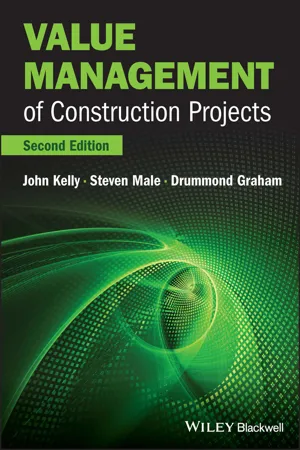
- English
- ePUB (mobile friendly)
- Available on iOS & Android
Value Management of Construction Projects
About This Book
VALUE MANAGEMENT OF CONSTRUCTION PROJECTS
Second Edition
Value Management is a philosophy, set of principles and structured management methodology for improving organisational decision-making and value-for-money. It is well-established in the international construction industry and has been endorsed as good practice in a range of UK government sponsored reports.
The authors have addressed the practical opportunities and difficulties of Value Management by synthesising background, international developments, and benchmarking with their own extensive consultancy and action research experience in Value Management to provide a comprehensive package of theory and practice. Covering methods and practices, frameworks of value and the future of value management, this thoroughly updated second edition extends the integrated value philosophy, methodology and tool kit to describe the application of Value Management to service delivery, asset management and programmes, in addition to projects, products and processes. In particular, the new edition responds to:
- A range of recent UK industry and government publications; and most notably BS EN 16271: 2012 - Value management: Functional expression of the need and functional performance specification; the imminent update of BS EN 12973: 2000 Value Management; BS EN 1325 Value Management – Vocabulary, Terms and Definitions; the changes to "Value for Europe" governing the training and certification of Value Management in European Union countries; the UK Government's Management of Value (MoV) initiative, and other leading reports, international guidance and relevant standards.
- Changes in Value Management practice, particularly in programmes and projects.
- Developments in the theory of value, principally value for money measures, whole life value option appraisal, and benefits realisation.
- Initiatives in asset management covering the management of physical infrastructure, for example the suite of three standards under the generic title of BS ISO 55000: 2014 Asset Management, and its predecessor BSI PAS55 2008 Asset Management: Specification for the Optimized Management of Physical Assets.
It contains a dedicated chapter of exemplar case studies which demonstrate the new areas of theory and practice, and an extensive set of tools and techniques of use in Value Management practice.
Public and private construction clients and construction professionals such as cost consultants, quantity surveyors, architects, asset managers, engineers, and project managers will all find Value Management of Construction Projects essential reading. It will also be of interest to researchers and students on construction related courses – particularly those at final year undergraduate and at Masters level.
Frequently asked questions
Information
Part 1
Introduction and Evolution of Value Management
- A system of function analysis promoting an understanding in and a clear definition of requirements of construction projects.
- An appreciation of the client's value system and the transference of this value system to the project effectively defining the criteria for project success.
- The value study process involving a structured stakeholder team.
- The Orientation and Diagnostics phase
- The Value Workshop phase
- Implementation phase
References
- Kelly, J. and Male, S. (1993) Value Management in Design and Construction: The Economic Management of Projects. London: E and F N Spon.
- Male, S., Kelly, J., Fernie, S., Grönqvist, M. and Bowles, G. (1998a) The Value Management Benchmark: A Good Practice Framework for Clients and Practitioners. London: Thomas Telford.
1
Introduction
1.1 The Aims and Objectives of the Book
What has Changed from Edition 1
- A range of recent UK industry and government publications, most notably BS EN 16271:2012 – Value management: Functional expression of the need and functional performance specification, the imminent update of BS EN 12973:2000 Value Management; BS EN 1325:2014 Value Management – Vocabulary; the changes to ‘Value for Europe’ governing the training and certification of Value Management in European Union countries; the UK Government's Management of Value (MoV) initiative, together with other leading reports, international guidance and standards on Value Management.
- Research in value management undertaken since 2002.
- Changes in value management practice, particularly in relation to the management of Portfolios, Programmes and Projects (P3).
- Developments in the theory of value, principally value for money measures, whole life value, option appraisal, and benefits realisation.
- New asset management initiatives covering the management of physical infrastructure, for example, BSi PAS55 2008 ‘Asset management: Specification for the Optimized Management of Physical Assets’, which has transitioned into a suite of three documents comprising the new standard BS ISO 55000: 2014 Asset Management (BS ISO 55000: 2014 Asset Management – Overview, Principles and Terminology; BS ISO 55001: 2014 Asset Management – Management Systems – Requirements; BS ISO 55002: 2014 Asset Management – Management Systems – Guidelines on the application of ISO 55001).
- A wealth of material contained within over 200 case studies undertaken by the authors as consultancy and research, and distilled into lessons learned and good practice.
The Objectives of the Second Edition
Table of contents
- Cover
- Title Page
- Copyright
- Preface
- Glossary
- Part 1: Introduction and Evolution of Value Management
- Part 2: The Anatomy of a Value Study
- Part 3: Whole-Life Business Value
- Part 4: Developments in Value Thinking
- Appendix: Toolbox
- Index
- End User License Agreement